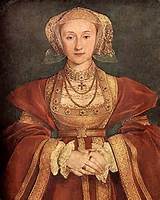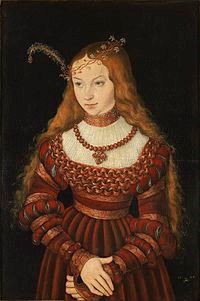Anne of Cleves: Character and Appearance

Until recently, Anne of Cleves was one of the least-known of Henry VIII’s wives. That Henry found her physically unattractive, which, paradoxically, made her ‘the lucky one’ whom he divorced, was about the sum of knowledge. Now, however, she is the focus of more interest, and as her life is examined in more depth, we are finding out far more – including about her own reactions to the annulment.
The contemporary evidence about Anne is largely second hand, as it is for Henry’s other wives. Only Katharine of Aragon left many letters. Knowledge of Anne must be derived from ambassadors’ reports, written by people assessing her worth as a spouse, rather than considering her as an individual.
The first mention of Anne in English sources is the report of John Hutton to Thomas Cromwell in the autumn of 1537. Hutton had been sent to the Low Countries to discuss possible alliances for Henry with the Hapsburgs or their allies. There were not many options - the daughters of the Emperor Charles and Ferdinand, King of the Romans, were too young; the regent of the Low Countries, Mary of Hungary, had no children, and the elder daughter of their sister, Isabel of Austria, was already married. That left only Isabel’s younger daughter, Christina of Denmark, who, although only sixteen, had already been married and widowed.
Hutton mentioned in passing, that the Duke of Cleves had a daughter but ‘there is no great praise of her personage or beauty’. This dispassionate account should, perhaps, have been taken more seriously when Anne came under consideration after negotiations for Christina and the French candidate, Marie of Guise, fell through.
In January 1539, with Charles V and François I swearing undying friendship, after twenty-five years of rivalry, Henry had to look elsewhere for a bride, and Anne came to the fore. One report to Henry claimed Anne’s beauty outshone that of her sister, Sibylla, married to Johann Friedrich of Saxony, ‘as the golden sun does the silver moon’. Since the writer thereof, Christopher Mont, had not seen Anne, but was a convinced Reformer, eager for the marriage to take place to promote an alliance with the Schmalkaldic League, it might have served Cromwell better had he sought other views. Of course, attractiveness is largely in the eye of the beholder, and it is unlikely that anyone would comment unfavourably on the beauty of a duke’s daughter.
It was difficult for any of Henry’s envoys to form a clear view of either Anne’s appearance or character. Etiquette at the Clevian court was strict – Anne and her sister Amelia wore ‘monstrous habit and apparel’ which made it hard to see their faces, let alone their figures. Attempts to see the young women at close quarters were rebuffed with the cold query as to whether the envoys wished to see them naked?
Henry was, nevertheless, determined to have some idea of what Anne looked like, and dispatched his court painter, Holbein, to Cleves. Etiquette must have been relaxed, because Dr Wotton, who was leading the embassy, got close enough to Anne to confirm that the painter had taken a good likeness. The envoys commented on Anne’s mother’s strictness and the rather limited education that the girls had received - focused on making her a thrifty and economical wife for a nobleman, rather than a queen and companion for a man of Henry’s intellectual tastes, although no inference was drawn that this disparity in education might make the couple incompatible.
Playing musical instruments, in particular, had not been part of Anne’s education, it being considered immodest for noblewomen in Cleves. This was very different from the attitude at the English court where the king and all his siblings and children performed to a high standard.
It was noted however, that, although she spoke no foreign languages, ‘her wit is so good, that no doubt she will in a short space learn the English tongue, whenever she putteth her mind to it.’
Another point in the lady’s favour, according to this report was that she was ‘not inclined to the good cheer of this country, and marvel it were if she should, seeing that her brother in whom it were somewhat more tolerable, doth so well abstain from it’. This was a rather convoluted way of saying that neither Anne nor her brother were heavy drinkers, despite that being common in Germany.
Henry was pleased with Anne’s portrait and the accounts of her, and confirmed to the French ambassador, that he knew his intended bride to be ‘of convenient age, healthy temperament, elegant stature, and endowed with other graces…’ This reference to Anne’s stature is echoed elsewhere – we can infer that she was taller than average for the time. Other limited descriptions suggest she was of a ‘brown’ complexion – not so ‘fair as the late queen’. Jane Seymour had been noted for her pale skin, considered a mark of beauty. Anne probably had fair hair. There is a strange tale in nineteenth century works that she wore a fair wig, but there is nothing in contemporary accounts to suggest this.
Anne’s hair is not shown in any of her portraits, but that of her sister, Sibylle, shows a woman with strawberry-blonde, or even red-gold hair. Of course, the sisters might well have had different colouring, and red hair seldom goes with a dark complexion.
The next contemporary information we have about Anne’s character is valuable, because it was written in a private letter, from Lady Lisle, wife of the Lieutenant of Calais, to her daughter, Anne Basset. Mistress Basset had served Queen Jane Seymour, and had been appointed to Anne’s household, so it was a matter of some importance to find out what her new mistress was like. Lady Lisle was very positive, writing that Anne was ‘so good and gentle to serve and please’.
As well as Lady Lisle’s letter to her daughter, the Lisle Letters contain a wealth of information about Anne’s sojourn at Calais, where William FitzWilliam, Earl of Southampton, was in charge of her reception. Southampton, who was personally close to Henry, seemed favourably impressed, perhaps disposed to like Anne because she had admired his ships. He told Henry that, having learnt a new card game to please the king she ‘played as pleasantly, and with as good a grace and countenance as ever in all my life I saw any noble woman…’.
Southampton clearly found Anne pleasant and gracious, eager to please, and ready to be pleased by anything that was done for her. ‘She was contented, and thanked me, praying me again to come to supper, and to bring some noble folks with me to sit with her, after the manner of her country.’ The earl was disconcerted by Anne’s request, it not being etiquette at the English court for him to dine familiarly with the queen. Nevertheless, she pressed him, saying that ‘she was much desirous to see the manner and fashion of Englishmen sitting at their meat.’
Having finally been persuaded by Anne, who was obviously eager to learn as much about her new home as possible, Southampton was impressed: ‘And on my faith,’ he wrote to Henry, ‘her manner, usage and semblance, which she showed unto us all, was such as none might be more commendable, nor more like a princess.’
Clearly, Anne had a grace and dignity that was highly suitable for a queen – nothing like a clumsy ‘Flanders mare’! That Henry called her by such an unkind name is a slur dating to the eighteenth century.
Later, Southampton, on being charged with not having told Henry the truth about Anne’s attractiveness (or perceived lack thereof) responded that, having heard nothing but praise of her, by the time she reached Calais, already promised to the king, it was ‘no time to dispraise her’. Even if Southampton had thought poorly of her, he could hardly criticise the woman who was about to be his queen. Nevertheless, his positive affirmations have the ring of truth.
The next description of Anne comes from the French ambassador, Marillac. Marillac was never very complimentary about any women at the English court, but he had no reason to either praise or denigrate Anne, whose brother, Wilhelm, had been an ally of François. His account seems reliable, although the first description is hearsay. He wrote that ‘according to several who have seen her close, she does not seem so young as expected, nor so beautiful as everyone affirmed. She is tall and has an assurance in her carriage and countenance giving the impression that vivacity of spirit will supply as much beauty as one could desire.’ He added that her ladies were even less good-looking, but they were all dressed in clothes so hideous they would have made the most beautiful women look ugly.
Henry’s immediate reaction to Anne is well-known, but the information comes from papers relating to the annulment case in June and July of 1540, in which he affirmed that he had told Cromwell immediately after meeting Anne that he did not want to go through with the match if it could be avoided. He also gave ungentlemanly reports of Anne’s body, as a reason for his inability to consummate the marriage – he had felt her breasts and belly, and wondered if she were, in fact, a virgin.
Dating from the same time (July 1540) is the report of Sir Anthony Browne, a Gentleman of the Privy Chamber, who had taken Henry’s present to Anne immediately prior to the king entering the room at Rochester. Sir Anthony claimed that, on entering the room, with a mind prepared by all the praise of her to find a beautiful woman, ‘he was never more dismayed in all his life, lamenting in his heart …to see the lady so far and unlike that was reported, and of such sort that he thought the king’s grace could not content himself with her.’ Sir Anthony may have been recalling a genuine memory or being wise after the event.
The positive aspects of Anne’s appearance and character that Henry could not deny, were her ‘queenly manner’ and dignity. Adding to this positive assessment of Anne, ambassador Marillac informed his master that the English in general were sorry for Anne’s repudiation. ‘It is a matter of great regret to these people, who loved and esteemed her as the sweetest, most gracious and kindest queen that they had known, or desired, for a long time.’ Marillac admired Anne – in his next letter, he wrote of the patience she was showing under affliction, accepting with good grace that which she had no choice but to endure. By August, he was reporting that Anne seemed positively jolly, wearing a different dress of ‘strange fashion’ every day, and so cheerful that she must either be unbelievably prudent in hiding her inner feelings, or insensitive to the point of stupidity to forget so quickly the humiliation she had suffered.
Following the annulment, Anne’s dignity and grace recommended her not just to Henry, but to Katheryn Howard, who succeeded her. But she was not a saint, and nor did she take the annulment as positively as is sometimes reported. Whilst she could not refuse to accept the verdict of Henry’s bishops that her marriage was invalid, far from thanking her lucky stars and being content with her role as Henry’s ‘sister’, after Katheryn Howard’s death, she fervently hoped that she would be reinstated as queen. When Henry married Katherine Parr, she was offended, complaining that the new queen was less attractive than herself.
Anne’s story is not one of unalloyed happiness – she had been publicly rejected, she could not return to Cleves as she would have been a penniless dependent on her brother, shamed and ridiculed, but she had no real role in England. In theory, she could have remarried, but there was never any real prospect of that. The gossip that floated around a year or so after the annulment that she had had a child was a further embarrassment. Henry had the rumours investigated and was satisfied that there was no truth in them, but it was clear that her servants were expected to report on her movements, and she could not correspond freely with her family – her letters were monitored.
Despite her mother’s careful upbringing, Anne does not seem to have been good with money. Henry gave her a very substantial income, but she was often in debt, even though she did not spend her funds on renovating her properties, and did not have the expenses of a ceremonial role to maintain. Arguments with the council of Edward VI over her lands and her debts were frequent.
Nevertheless, Anne was greatly loved by those who served her. Her comprehensive will named nearly all her servants individually, and she gave generous bequests to the villages where she had mainly lived – Richmond, Hever, Bletchingly and Dartford. She hoped that Queen Mary would honour her bequests, and left keepsakes both to both her step-daughters, as well as to Katherine, dowager-duchess of Suffolk, who had first welcomed her to England. This was a brave move, as Katherine had gone into exile during Mary’s reign.
The chronicler, Holinshed, writing not long after Anne’s death, summed her up as ‘a lady of right commendable regard, courteous, gentle, a good housekeeper and very bountiful to her servants.’
It is probably fair to conclude that Anne was neither especially pretty, nor unusually plain. She was tall, slim, and had a dignified and queenly manner. As a mistress, she was easy to serve, and her character was gracious and kind. Her acceptance of her situation and her efforts to make the best of it can only be admired.





